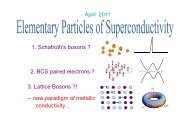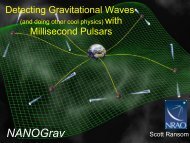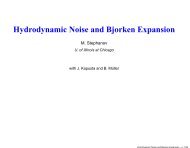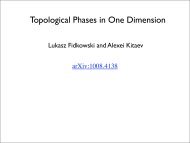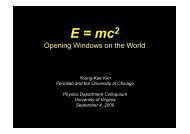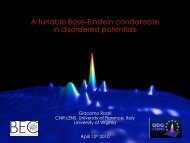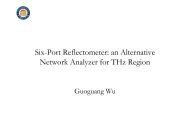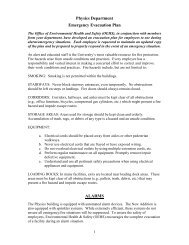Fractional topological insulators
Fractional topological insulators
Fractional topological insulators
Create successful ePaper yourself
Turn your PDF publications into a flip-book with our unique Google optimized e-Paper software.
c)<br />
ε/t 1<br />
2<br />
0<br />
− 4π<br />
k x<br />
4π<br />
3 √ 3<br />
3 √ − 2π 3 3<br />
Can one get perfectly flat bands?<br />
0 0<br />
les d) of Hamiltonians of the the form (1a) are<br />
ε/t 1<br />
g. Example 1: The honeycomb lattice. We<br />
he vectors 2 a t 1 =(0, −1), a t 2 = √ 3/2, 1/2 ,<br />
/2, 1/2 0 connecting NN and the vectors b t 1 =<br />
= a t 3−a –2<br />
t 1, b t 3 = a t 1−a t 2 connecting NNN from<br />
omb lattice depicted in Fig. 1(a). We denote<br />
− π<br />
ve vector fromk x the BZ 0 of the reciprocal 0 lattice k y<br />
triangular lattice spanned by b 1 and b 2 ,say.<br />
is then defined by the Bloch Hamiltonian [1]<br />
FIG. 1. (Color online) (a) Unit cell of Haldane’s model on the<br />
honeycomb lattice: The ψ † kNN H kψ hopping k , amplitudes t 1 are real<br />
(solid lines) and the NNN hopping amplitudes are t 2 e i2πΦ/Φ 0<br />
k∈BZ 3<br />
in the direction of the arrow (dotted lines). The flux 3Φ<br />
Band 0,k −Φ<br />
:=<br />
penetrate<br />
2t 2 cos Φthe dark<br />
cosshaded k · b i ,<br />
region and each<br />
(2a)<br />
of the<br />
light shaded regions, i=1 respectively. For Φ = π/3, the model<br />
⎛<br />
is gauge equivalent to having one flux quantum per unit cell.<br />
(b) The chiral-π-flux<br />
3 on the square lattice, where the unit cell<br />
corresponds to Hthe k flat<br />
shaded := H k<br />
B k := ⎝<br />
t ⎞<br />
1 cos k · a i<br />
t 1 sinarea. k · aThe NN hopping amplitudes<br />
are t 1<br />
|ε i<br />
⎠ , (2b)<br />
e iπ/4 in the direction of −,k<br />
|<br />
i=1 −2t the arrow (solid lines) and the<br />
2 sin Φ k · b i<br />
NNN hopping amplitudes are t 2 and −t 2 along the dashed and<br />
≥dotted 0 and<br />
lines, respectively.<br />
t<br />
(c) The band structure of Haldane’s<br />
2 ≥ 0 are<br />
model for cos Φ =1/(4t 2 )=3 NN and NNN hoptudes,<br />
3/43 with the flatness ratio<br />
1/7. √ (d)<br />
respectively,<br />
The band structure<br />
and<br />
of<br />
the<br />
thereal chiral-π-flux<br />
numbers<br />
for<br />
±Φ<br />
t 1 /t 2 =<br />
gnetic 2 with the fluxes flatness penetrating ratio 1/5. The the lower two bands halves can be of made<br />
exactly flat by adding longer range hoppings.<br />
H 0 = <br />
To enhance the effect of interactions, highly degenerate<br />
(i.e., flat) bands are desirable. It is always possible to<br />
π<br />
− π<br />
k y<br />
2π<br />
3<br />
π<br />
H k = B k · σ<br />
nal unit cell. For t 1 t 2 , the gap ∆ ≡<br />
max k<br />
ε −,k<br />
is proportional to t 2 . The width<br />
r band is δ − ≡ max k<br />
ε −,k<br />
− min k ε −,k<br />
. The<br />
io Thursday, δ − /∆ is extremal for the choice cos Φ =<br />
March 22, 2012<br />
a) b)<br />
c)<br />
ε/t 1<br />
2<br />
0<br />
ψ † k = c † k,A ,c† k,B<br />
⇒ In real space, hoppings decay exponentially with distance<br />
d)<br />
− 4π<br />
k x<br />
4π<br />
3 √ 3<br />
3 √ − 2π 3 3<br />
ε/t 1<br />
2<br />
0<br />
–2<br />
− π<br />
k x<br />
A i<br />
B i<br />
A i<br />
0 0<br />
0 0<br />
π − π<br />
k y<br />
k y<br />
B i<br />
<br />
2π<br />
3<br />
π<br />
2



